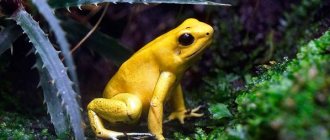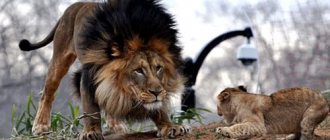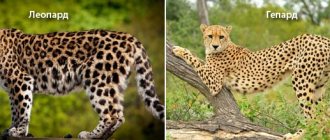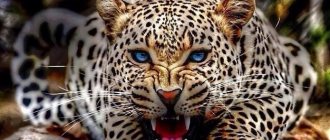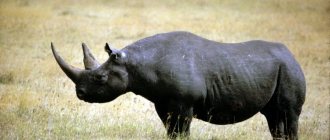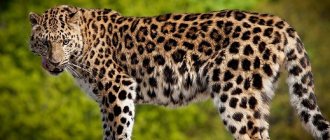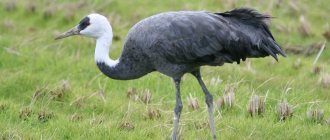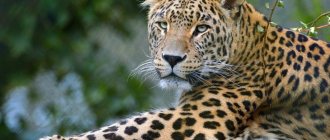Many are convinced that only large black animals belonging to the cat family are called panthers. From the point of view of biological classification, such a statement is incorrect. The genus Panthera includes five species of modern predators: lions, tigers, jaguars, leopards and snow leopards, as well as a number of fossil animals. The presence of black coloring is not a prerequisite for calling an animal a panther.
Black Panther
Leopards and jaguars, whose skin is colored black due to a special combination of genes, are colloquially called black panthers. This coloration is not a species characteristic, but simply serves as a distinctive feature of individual individuals.
Appearance of panthers, what colors are they? The effect that leads to the appearance of the black pigment melanin on the fur of animals is called “melanism” and is a consequence of a gene mutation. If such a color helps the animal survive, the trait is passed on to subsequent generations. Incomplete melanism, resulting in the presence of dark-colored fragments on the animal skin, is called “abundism.”
Dark-colored leopards and jaguars have an advantage over their lighter-colored relatives when living in shady forest areas. Darkness provides reliable cover for the black-skinned predator and helps it sneak up on its intended prey unnoticed. By creating more favorable conditions for the survival of cats with dark colors, the environment helps to consolidate the traits in the offspring. Thus, among wild cats living in the jungles of Malaysia, black color is predominant. This characteristic first arose by chance, and then became established through the process of natural selection.
Representatives of the Jaguar and Leopard species, regardless of color, have skin that is replete with characteristic round spots - “rosettes”. Similar marks can be seen on the dark skin of melanistic animals. In cats with an incomplete form of melanism (abundism), the color of the skin resembles chocolate with varying degrees of saturation, and the rosettes are bluish-black.
Dark coloring is the only biological difference between black leopards and golden ones. All animals of this species can form pairs and give birth to offspring. The probability of birth of dark individuals is much less, since the melanism gene is of a recessive type.
Abundant cubs appear more often in representatives of the Leopard species. Sometimes the effect of incomplete melanism manifests itself in an increase in the number and size of rosette spots. This phenomenon is not always genetically determined. The color of the baby can be affected by natural factors that affected the pregnant female, for example, air temperature.
Photo of a black panther in the wild
Diet
Mostly these predators prefer to feed on ungulates: antelopes, gazelles, wild boars, deer and livestock are the main diet of the African leopard. They can also eat birds, rodents, arthropods, reptiles, and carrion. The weight of prey ranges from 10–40 kilograms.
Wild cats hunt by setting up an ambush - they lie in wait and pounce on their prey - in most cases, the victim does not even have time to react, because this predator sneaks silently like a cat and attacks with lightning speed. The leopard immediately bites into the neck of the victim, which causes instant paralysis in the second, then strangles her and takes her to a quiet, secluded place. The great strength of African cats allows them to hunt prey that is 10 times their weight.
Evolution and habitats
Translated from the language of the ancient Greeks, the word Panthera means “largest beast.” Biologists include the most formidable predatory mammals in this genus.
According to researchers, different species of large cats have a common ancient ancestor, Panthera schaubi, widespread in Asia 6-10 million years ago. About 3 million years before our time, the first individuals similar to modern tigers formed. Extinct representatives of the genus include the European Jaguar, the remains of which were found in Italy.
According to modern classification, clouded Asian leopards are classified as a separate genus. Scientists have differing opinions regarding the origin of snow leopards.
Modern Panthera are the largest representatives of the cat family. The most impressive dimensions are the Amur tigers, whose weight is often over 400 kg and their length is up to 4 m.
Characteristic features:
- developed muscles;
- large paws;
- big head;
- powerful jaws;
- the ability to hide claws inside the finger pads;
- the ability to produce a roar using the vibration of a plate under the tongue.
A common feature of cats from this genus is a significant difference between females and males in size and body structure. The differences are especially pronounced in Leos (mane, tassel on the tail).
The female's pregnancy lasts 3 months.
Where is it found, habitats? Panthera are distributed in southeastern Europe, Asia, Africa, Central and South America, and the south of the North American continent. Animals inhabit subtropical and tropical forests, as well as steppe and desert zones. The cold climate serves as an obstacle to settlement, although animals can withstand daily temperature fluctuations without difficulty.
Attacks on people
Unlike other predators, pumas rarely attack humans. They prefer to avoid meeting him. Since 1890, about 100 attacks on humans have been officially recorded in the United States and Canada. Sixteen of them were fatal. The attacks occurred at night or at dusk.
Puma (Puma concolor)
Cougar, mountain lion, red tiger, deer cat, mountain devil, king cat, lesser panther - these are all the names of one cat. She also has another name, better known to us - it is a puma. That was the name of the predator by the Quechua Indians.
This feline mammal is widespread in America (from Canada to Patagonia) and has long become a symbol of these places. Cougars are found on the plains, in forests, and in mountainous areas. They try to avoid wetlands, as their main rivals, jaguars, live there. Pumas are quite common on our planet. Their population is not decreasing, despite the fact that there is a constant hunt for these cats.
This is due to the fact that cougars adapt well to new conditions.
The body length from the nose to the tip of the tail can reach 274 cm, height - 60-80 cm, and weight - almost 100 kg, with males being twice as large as females. Only newborn puma kittens have pronounced spots, while adult individuals are uniformly colored. Their coat color can be golden or gray-brown. The belly and chin are almost white, and the tail is dark. There are 24 subspecies of cougar. Little is known about some subspecies. The most famous is the Florida cougar, a tawny cat with long legs.
The puma is a formidable predator. She is armed with four-centimeter fangs, which make it easy to deal with any prey. This cat is equally active both day and night. In this regard, they are driven only by hunger. But most often their favorite time to hunt is twilight. The already silent animal becomes completely invisible. They like to wait for their prey, sitting on trees or rock ledges, which they can easily climb. When hunting, cougars use the factor of surprise. Moreover, this animal does not like to run - it quickly runs out of steam. This is compensated by silent sneaking and fantastic jumping ability: it can jump up three meters or fearlessly jump from the height of a six-story building. Puma can also attack large animals, such as deer or elk. She throws it right at the throat and bites it. It can knock down small prey with one blow of a strong paw, thereby breaking its cervical vertebrae. Their main food is mice, voles, prairie dogs, marmots, birds and monkeys. Very rarely, cougars attack livestock.
Cougars live up to about 20 years. These predators prefer to live and hunt alone, but for several months after birth, the cubs live with their mother, who protects them and teaches them how to hunt. After the mother leaves them, the kittens stay together for a few more weeks, but then each begins an independent life. The territory of each individual sometimes extends over tens of square kilometers. The boundaries of the property are inviolable, and there are no fights for territory between cougars: the cougar will not encroach on someone else’s land if it senses that it already has an “owner.” It happens that a cougar is driven out of its territory, then the cat is forced to look for a new one. Then they try to quickly pass other people's borders and settle in free territory. The path is not short. For example, Wyoming pumas were found half a thousand kilometers away - in Colorado.
Cougars rarely attack people, because they are a non-aggressive animal.
On the contrary, the puma tries to be careful and get away from people. Rare cases of aggression are associated with the increased interest of hunters in this cat
Best articles: Instructions for use of Ovariovit
In 1995, a real killer cougar appeared in Mexico, she attacked all the people who met her on the way. 18 people died from her claws. When the puma was caught and examined, it turned out that the cat was mutilated. Apparently, some incompetent hunter did not kill the puma, but only wounded it. The cougar survived, but was left crippled. Hence such ferocity towards people.
Compared to tigers or lions, pumas are less dangerous to people. All fears of these animals are rather superstitious. For example, according to the belief of North American Indians, pumas are devilish animals. Her roar alone is worth it! Indeed, when a puma is angry, it makes a sound a little like a locomotive signal. But in other cases, she makes purring sounds, like domestic cats. Remember, if a cougar is not wounded, it will not attack a person, but will try to get away.
Therefore, when meeting this cat, you should not panic, you must behave carefully and prudently
| Length: can reach 274 cm Weight: almost 100 kg Habitat: America (from Canada to Patagonia) |
Lifestyle
The behavior of representatives of the genus Panthera has common characteristic features. Predators go out hunting at night, prefer to act from ambush, and lead an isolated life. The exception is Lions, who form groups of several individuals and use a driven method of hunting.
Like any cats, Panthers live in a certain territory (up to several tens of sq. km.), They mark the boundaries of their possessions, carefully protecting them from competitors.
Behavior
Leopards are predators who mark their territory with their claws and urine. While eating, leopards purr, and the rest of their communication with their relatives occurs through growling and coughing.
When hunting, a leopard moves very slowly and gracefully, without attracting attention to itself. These predators do not have a need for water, since they receive the bulk of the liquid from their prey.
The leopard is a very fast animal, it can move at speeds of up to 60 km/h and perform jumps over six meters long. They also have very sharply developed vision and hearing, which is necessary for hunting in dense forests.
Reproduction and lifespan
Females of large cats are ready to mate when they reach 1.5-3 years, males - a little later. There is no mating season; estrus continues until pregnancy occurs. Males prefer to live separately from females (with the exception of lions). The female independently takes care of the offspring, feeds and trains the babies. How long does he live? Representatives of the genus Panthera live from 12 to 25 years in natural conditions, and much longer in captivity.
Photo of a leopard and a black panther
Extinct species
The existence of many species of predators that have not survived to this day is evidenced by preserved skeletal bones. Research has made it possible to identify the main species of these animals, which include: the ancestors of leopards and pumas, two types of European jaguars, the ancestors of lions and tigers, and large lion-like cats Pahthera youngi.
More recent fossil animals include:
- tiger ancestors of the subspecies tigris acutidenis and tigris trinilensis, distributed in Siberia, China, and the islands of Indonesia;
- Cave Lions from the North American continent, distinguished by the absence of a mane;
- European cave Lions, painted with stripes like tigers;
- spotted lions from Africa;
- Ceylon Lions;
- European subspecies of Jaguars and Leopards.
In addition to the animals mentioned above, the cause of whose extinction was the natural course of the evolutionary process, several species are known that disappeared thanks to people:
- Tigers from o. Bali, the last copy of which was destroyed in 1937;
- Tigers of Transcaucasia are large animals that fought in gladiatorial battles of Ancient Rome;
- Tigers from o. Java, who survived until the eighties of the twentieth century;
- a Texas species of Jaguar that has ceased to exist today.
Nutrition
Leopards are absolutely predatory animals. They feed on a variety of roe deer, antelope and deer. Hunting for their prey is organized near bodies of water. In addition to artiodactyls, leopards can feed on the carcasses of hares, birds and some monkeys. During periods of lack of food, they do not hesitate to eat carrion.
Leopards tend to steal food from each other, since it can stay in the territory of another predator for a long time. As a rule, their shelters are located in root hollows of trees, on scattered stones and in rock overhangs.
Confinement
Most people look at cats of the genus Panthera not as enemies or a desired hunting trophy, but as an integral part of the animal world of our planet. At the state level, measures are being taken to protect these beauties from barbaric extermination.
Many specimens of predators have found shelter in zoos in large cities, where conditions similar to the usual habitat of Panthers have been recreated. Protected areas and national parks in many countries take care of the growth of animal populations.
It is not uncommon for predators to be raised by humans. In the United States, 12 thousand tigers are in private hands. And this is provided that in many states there is a complete ban on such keeping of wild animals. Most pets have never lived in freedom and are descendants of circus animals or zoo inhabitants.
As a rule, animals living in captivity live longer lives than their wild relatives. For example, male lions live for more than two decades, whereas in natural conditions they usually die before they even last a decade. Today, zoos around the world have more than 1,000 lions.
The history of taming Lions is quite old. It is known that the commander Alexander the Great owned several tame lions brought from India. During the Roman Empire, animals took part in gladiator fights.
The keeping of large cats in medieval menagerie was characterized by cruelty. Since the Lion symbolized power and might, people often used animals for spectacular fights. Lion skins and heads were considered desirable hunting trophies. All this led to a sharp decline in the number of Panthers and threatened the existence of the population.
Modern humanity strives to correct the mistakes made in previous times. Living in captivity for large cats is organized humanely, taking into account the vital needs of the animals. Species that are at risk of extinction are listed in the Red Book and are protected by international laws.
The image of the black panther in human culture
The graceful, coal-colored predator has long attracted people's attention. The image of this beast can be found on the aristocratic coats of arms of the most glorious European monarchs. German heraldists preferred to use modified images, adding horns, cow ears, and a fiery tongue.
Our contemporaries associate the image of a black panther with Bagheera from Kipling's The Jungle Book.
Numerous dream interpreters offer the following interpretations of the appearance of a predatory cat in a dream plot:
- An animal proudly walking through the forest is the fulfillment of ambitious plans.
- A predator climbing a tree is a career failure.
- Hunting scene - quarrel with friends.
- A female with babies is a chance meeting with an interesting person.
- A predator caught in a cage is the fulfillment of a plan.
- A large animal means an enemy, and the coal color indicates that the enemy has influential support.
- A battle in which the predator wins means failure in business.
- A battle in which a man defeats a beast is success in his endeavors.
- A tamed and affectionate panther is a significant success and an increase in authority.
- Feeding a predator from your hands means support from high authorities.
